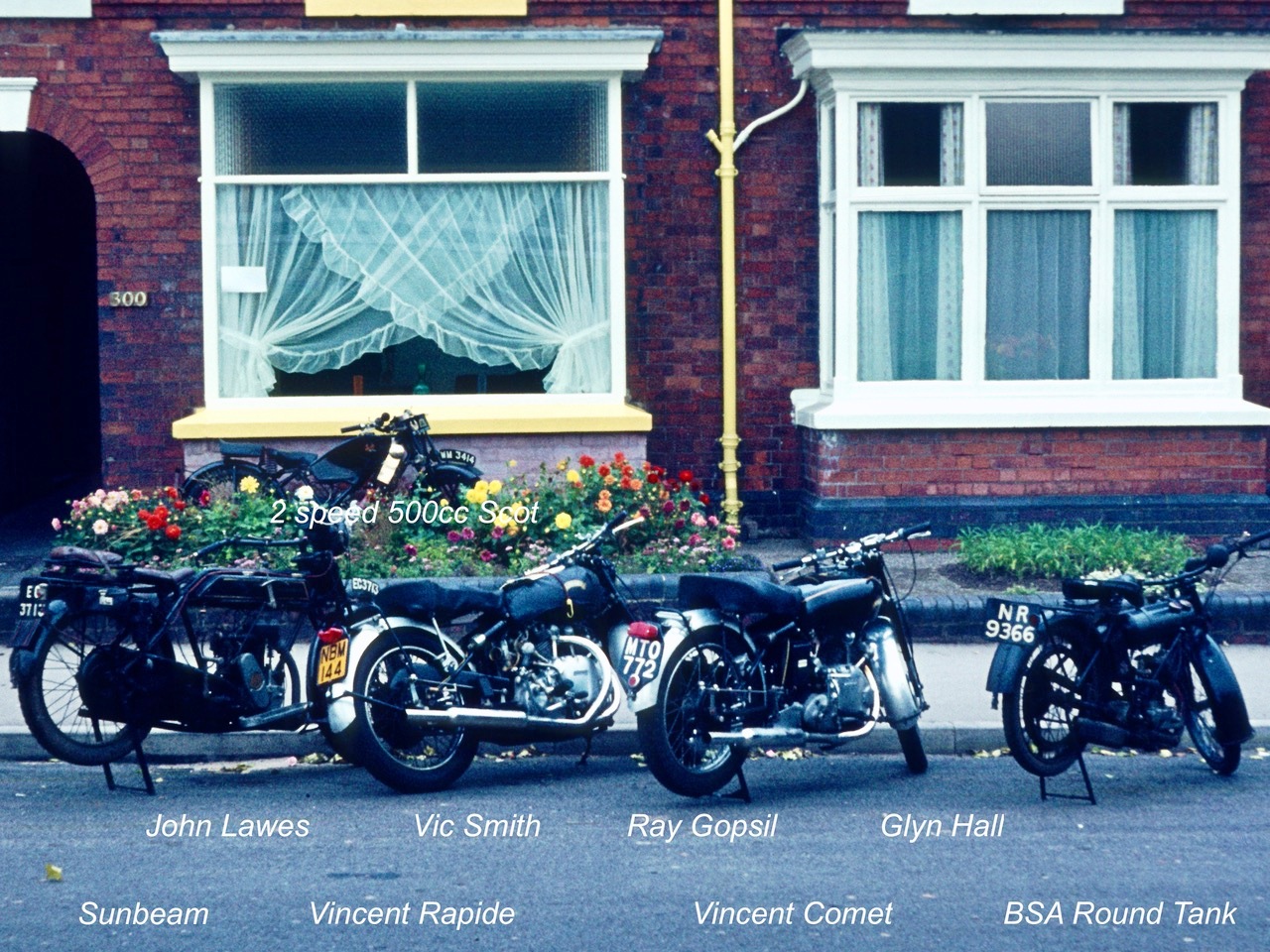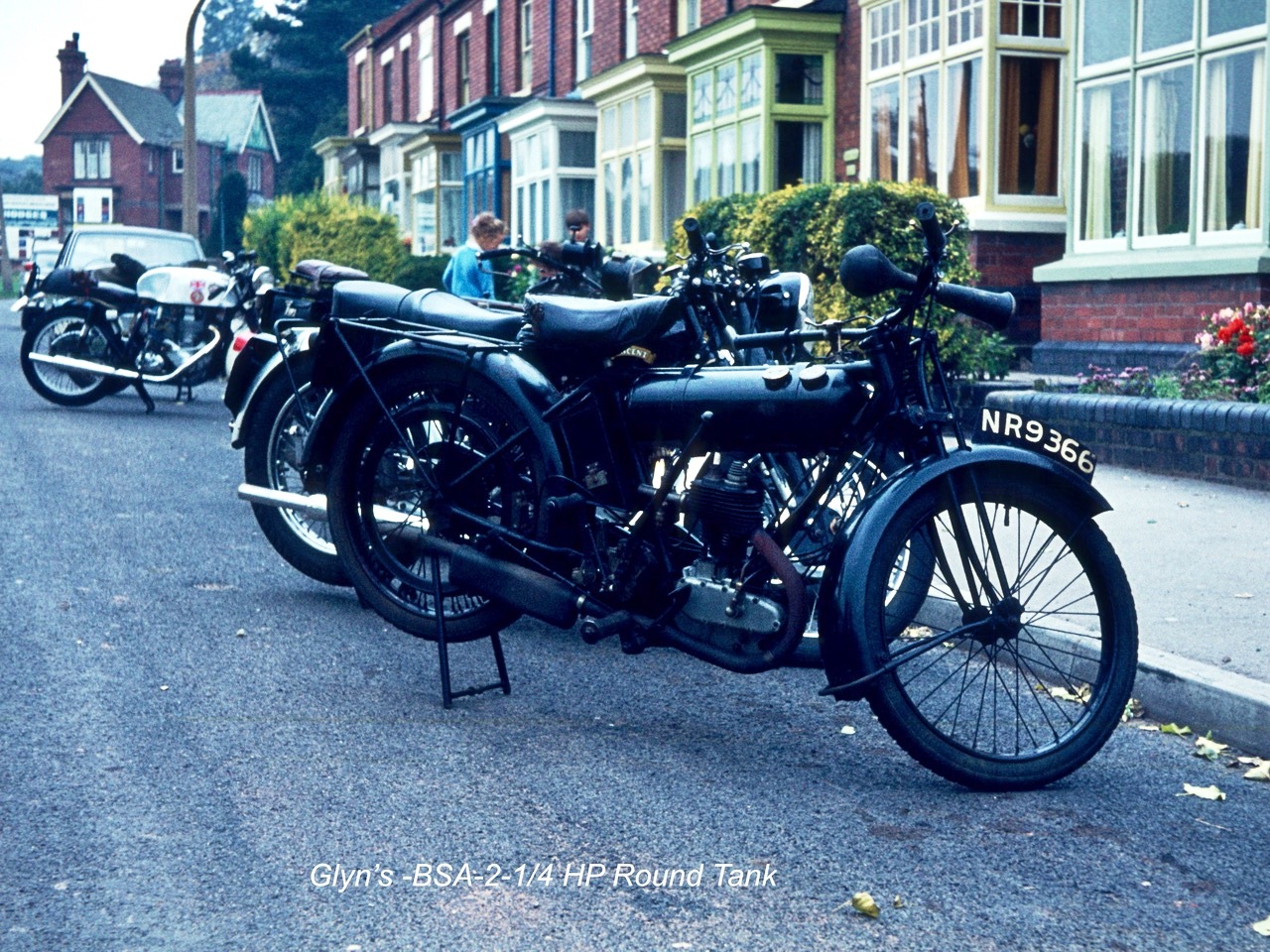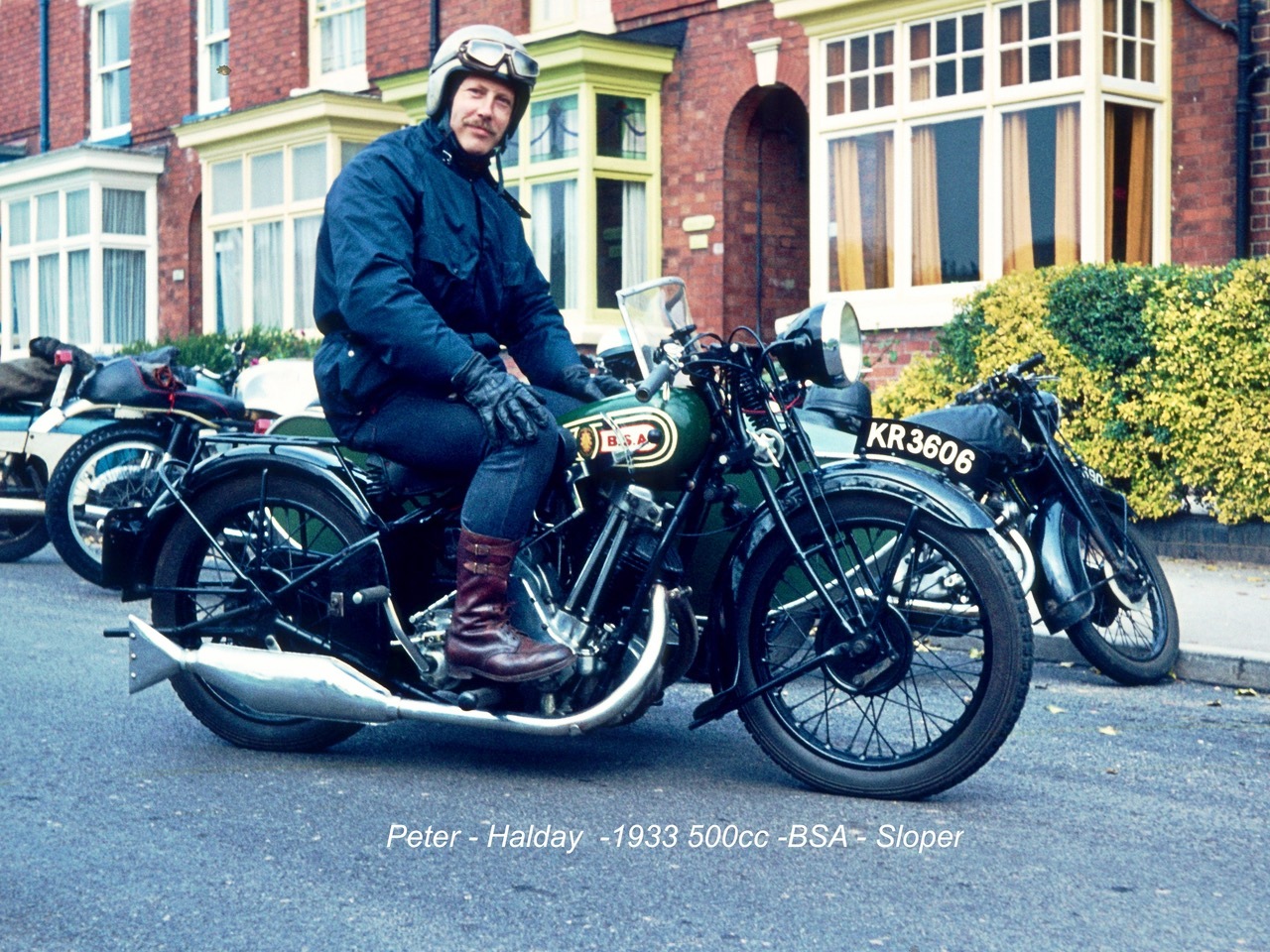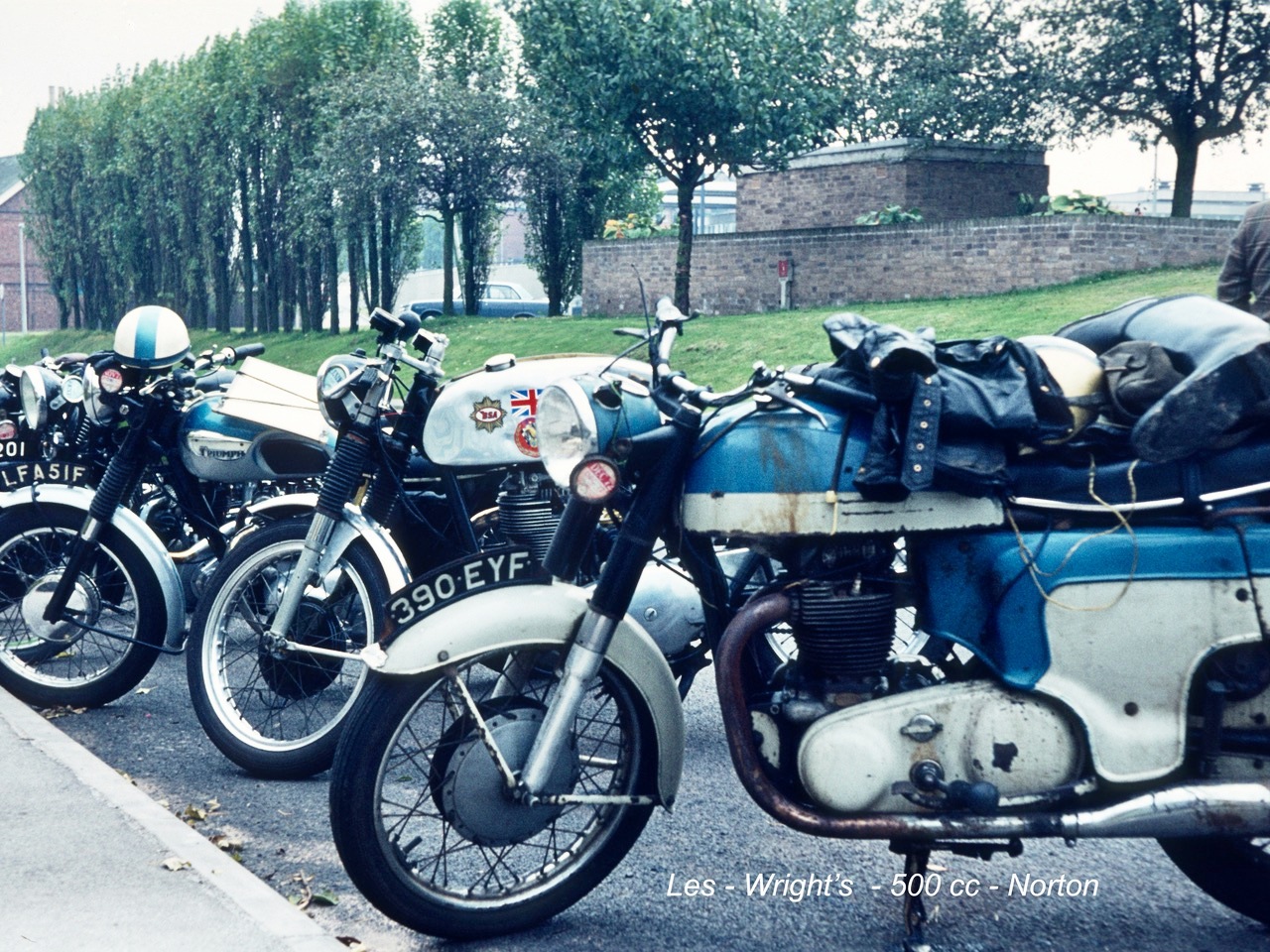Chat 23
Chat 22 Picture Quiz Answer = A wick trimmer for an Aladdin paraffin heater. Nobody got the correct answer. I guess that paraffin heaters are not used much these days as nobody got the correct answer.
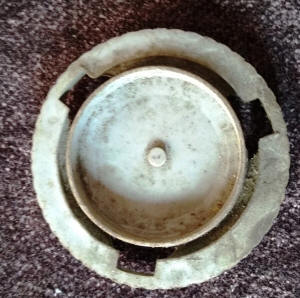
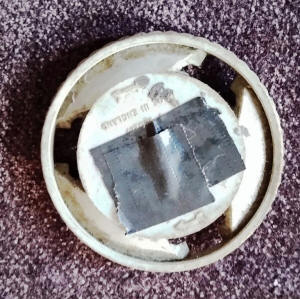
Picture Quiz. What five letter word links these four pictures? Answers by email to: edgrew@virginmedia.com
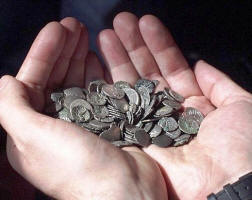

.jpg)
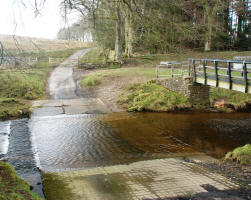
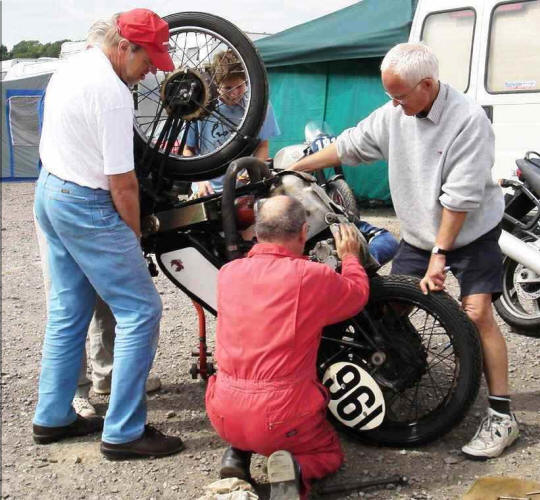
What do you think is going on in this picture of Roger Moss and helpers holding his Scott racer upside down?
This photograph was taken at a vintage race meeting at the Lydden Hill circuit in Kent. It was a fine weekend and I rode down to the circuit on my Ducati, you can just see the back end of it on the right of the photograph.
Roger was having a break from racing his Scott and New Zealander, Paul Dobbs had taken over the reins. Paul had a lot of racing experience on many circuits including the Isle of Man where sadly he was to lose his life some years later. Paul had changed the layout of the handlebars and seat to suit his riding style and being young and fast he was soon making his mark in vintage races.
Roger wasn't happy about how the Scott was running and decided to check the ignition timing. Tony Harris (who has contributed several interesting articles to these chats) at this time was making the new BT-H magnetos that he had designed. These units had no contact breaker points, being triggered electronically. A convenient feature of Tony's design was an access hole in the body that gave access to a hole in the magneto shaft. When the the shaft is turned until the hole in the shaft lined up with hole in the body, the stainless 6mm diameter rod supplied with the magneto could be inserted, locking the magneto at its firing point while setting the ignition timing.
Space for the magneto was limited on Roger's Scott so it was a little awkward to get the rod in the hole in the magneto. To make it a little easier Roger had shortened the rod a little. Everything was going well until .... Roger unfortunately let go of the rod so it slid further inside. Normally this would not have been a problem but in this instance the shortened rod left nothing sticking out to get hold of to remove the rod. Panic!
With the rod stuck inside the magneto the bike couldn't be run, what to do? Time before the racing started was running out. No time to start dismantling and get the magneto off. After wasting time unsuccessfully poking about with bits of wire trying to fish the rod out we were running out of ideas, a quick fix was needed.
Now you know why the bike was upside down. It was a simple non-technical solution. With the bike upside down and a bit of a shake the rod just dropped out.��������
How many people does it take to check the ignition timing on a Scott with this setup? If you are not careful it is more people than you think or at least enough to help you turn the bike upside down.����
Part Five of Pat Robotham's Motorcycling
Memories.
In terms of rebuilding bikes I was still at
it. For some unaccountable reason I got heavily into Ariels from
the 1931/ 32 period.
Like many manufacturers in that post
financial crash period Ariel were in the process of going under.
They had been a very successful middle sized
company, making and marketing a limited range of motorcycles which
used a large number of common parts. In 1930 the made a 250 ohv, a
550 side valve, and three versions of the 500 ohv one of which had
four valves. And they were dabbling with the early ohc Square Four.
But a small range, very efficiently produced using many common
parts. Come the fall out of the Wall street crash, markets shrank.
The companies’ response from my perspective was madness. They opted
to go for a huge expansion of models. To at least eleven, there may
have been a few more but some are so obscure, I may not be aware of
them. They had 250s, 350s with engines leaning forward 15 degrees,
500's side valve, overhead valve, two valve and four valve, all
engines sloping at 30 degrees, 500 vertical engine models
side valve, overhead valve, 2
valve and 4 valve, and an OHC square four. If the range
expansion was silly, and an attempt to chase fashion, then the lack
of the use of common components was ridiculous, Nothing was
interchangeable between the different model groups and also between
models so the 250 used different bottom end to the 350 for example.
The outcome was financial disaster. Most of the bikes were quite
good but in a shrinking market, there was only one way to go , down.
The company did rise from the ashes, and for 1933 it was back to a
mush smaller range with lots of common parts again.
So for some unaccountable reason I was attracted to these bikes. I picked up an absolutely complete MF32 350 OHV inclined engined one from a guy in Huddersfield, brought it home and restored it in two months. The bikes history spoke volumes of that financial period, made mid 1932, sold first to a customer in 1936, a very slow market.
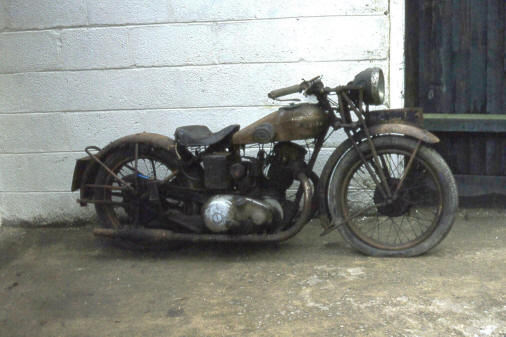
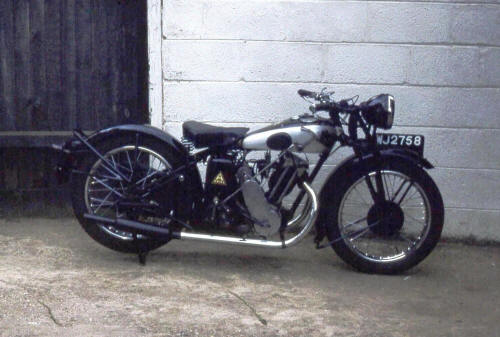
Before and after restoration photos of the 350
I built the bike for Shelley to ride which
she did, but as the kids grew it became too small two up, and I
found a 500 OHV Sloper 1932 kit of parts and decided to build that.
By that time we had moved to a house on
Fauld camp, which had recently been released by the MOD , it needed
a lot of work and also had no garage. So we had two kids a house
under reconstruction and three motorcycle in the rooms. Friends
allowed me to leave stuff with them, while we built a garage over
the following winter and summer.
I kept the 350 for a number of years and I
rode it a fair bit, when Shelley wasn’t using it. It was a very
nice, nippy machine which handled very well. It had clearly
been built down to a weight, as it fell into the special low weight
tax bracket introduced in 1931. I remember having to get it
weighed on a weigh bridge to get it taxed. It was physically a
bit small for me but otherwise a nice machine, well thought out and
executed. I have recently built and ridden a 250 side valve
version of this machine and that was truly appalling.
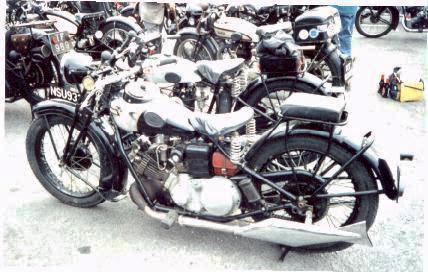
By now we had moved to Beamhill in Burton to
be closer to the kids school, This meant I was commuting about forty
miles a day to Derby and back , mostly I was doing it on the R80GS
which was fine but when the mood took me a trip through the back
lanes to work was accomplished on something a bit earlier. We had a
BSA three-wheeler car which was a great bit of kit, I had got it a
few years before as a barn find in Essex and rebuilt it including a
new body. They were a
tenth the price of Morgan's, and in my opinion, just as good. In some
respects they were better although they did not have the gut
wrenching performance of a Morgan they did not have the constant desire
to self destruct under the pressures of engine vibration and value
engineering, common Mog attributes. We used it a lot in rallies and
the kids were carted about in it even though they did not always
want to be seen in it as it damaged their street cred particularly
outside the school.
In pursuit of a change I decided we should go
MCC trialing together in a car, so did a deal with a fellow
competitor, his Mk 1 Dellow trials car for my R80GS and some cash.
The Dellow trials car
was built especially for trials in the 1950s into the early 60s.The
chassis was massive tubes which were chrome molybdenum steel from a
batch that the builders Mr. Delingpole and Mr. Low had bought as army
surplus after the second world war. It had originally been meant for
the production of four inch diameter mortar tubes. Onto this very
rigid, reasonably light chassis was mounted a steel tube space
frame, clad completely in Aluminium. All the mechanical parts came
from E93A ford side valve components supplied direct by Fords. This
was not a kit car. Ours originally had a supercharger fitted but
that had been removed, less power, but the engine lasted longer. As
already said I was not as good in a car off road as on a bike. I was
at least quite competent, on the latter.
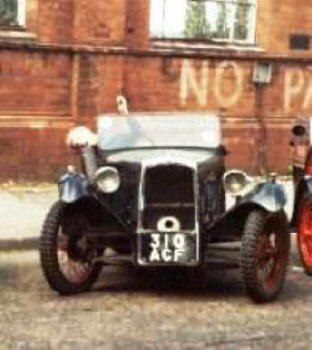
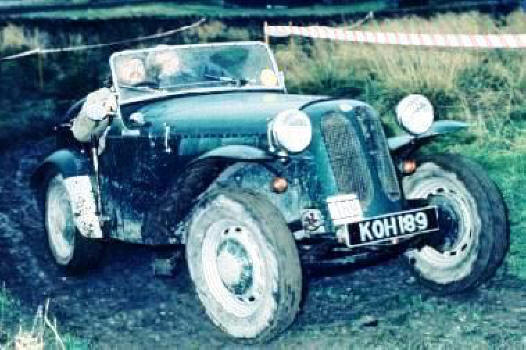
The BSA three-wheeler and Dellow trials car
Anyway we needed space in the garage, the kids
could be carted around on bikes so the BSA trike had to go. I
swapped it for a complete Model X matchless motorcycle in solo trim.
A really good bike. Masses of power, low down. Decent brakes and
decent steering and handling so long as it was not windy. Shell and
I even went green laning on it two up through Grizedale forest on a
VMCC South Lakes Mountain Run. Probably not the best option but we
came to no harm. The bike was heavy with a lot of weight on the
front wheel in addition it had a very large front mudguard, which
tended to catch the wind. So riding at lower speeds on a windy day
could be interesting.
I kept it for a couple of years and then was offered a series B Vincent Rapide, by Geoff Davies of the North Staffs section. He had bought it off the estate of the late Gordon Griffiths but could not get on with its overall size. It was a well known bike in good nick, these chances don’t come up very often so I sold both the Model X and the Ariel AKD V twin to raise the money. Oddly both these bikes went abroad which probably reflected the UK economy at the time.
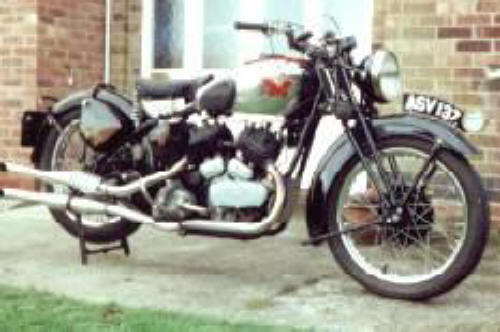
Model X Matchless and Vincent Rapide
We kept the Vin for about fifteen years and
rode it a lot, I had started working in Stoke so was commuting sixty
plus miles a day and often used the Vin for this. It was comfortable
for both passenger and rider, went well, stopped well and steered
well. Basically the previous long-term owner Gordon had had it forty
odd years and it was completely sorted, with some very sensible
mods. He had even replaced the Vincent clutch with a Norton one,
which certainly worked fine.
I did have a couple of engine problems and had
to take it apart once. I asked a well-known Vincent specialist what
I needed to do this, and was told. “ a lot of cardboard boxes and a
lot of labels”. Not very helpful, but not wrong. I believe some
cynics used to say they were a series of engineering solutions
looking for problems to solve. I cant comment, it worked well for me
but it did have a lot of parts.
It was also not very good in the dark so I did
not tend to commute on it, in the winter. To avoid riding it into
the ground I bought a modern bike, an MZ Skorpion, with a Yamaha
engine, designed by Seymors. It was a good looking bike, and I rode
it for about four years up and down the A50 to work and back, but
the finish was shocking it could not stand the winter salt and the
paint fell off in shards and the unsealed wheel bearings rusted
solid in a few thousand miles. Eventually I took it to DKs in
Newcastle, who claimed that as it had a very high mileage about
fifty thousand, they would have the scrap if they took it in part
exchange for a one year old BMW F650. I said I didn’t mind what they
did so long as they let me have £1000 off the BMW as an exchange
price. After a lot of muttering they agreed.
I used the BMW, which seemed a great bike with its Rotax
engine, over the summer and continued commuting on it until
Friday night of the second week in Dec 1999. I was stopped
and turning right from the Tutbury
to Burton road, about a mile from home, going up into
Longhedge lane .
I remember a squeal of tyres and nothing else,
I came to lying face up with the drizzle landing on my face. I was
aware of my right arm sticking out into the traffic, which was still
driving past. I tried to move it and nothing happened. I had to pick
it up with the other hand and move it like that it felt weird.
Apparently a nurse from the Burton hospital had run straight into me at about fifty miles an hour. The bike shot out from under me and disappeared into the opposite hedge and I was thrown under the wheels of a small truck. So that was Christmas 2000 taken care of. There followed a series of about six operations on arm and leg. Brian Slack leant me his wife’s spare wheel chair for six months and I ended up with one arm and one leg shorter than the other.. What to do next? At least I wasn’t on the Vin.
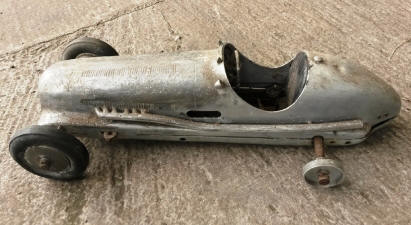
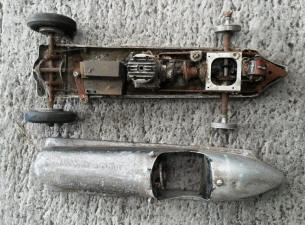
Before restoration
The engine was carried in a sub chassis together with the rear axle
and transmission. At the rear of this, which formed the tether
attachment point it had been stupidly cut off many years ago. I made
a new steel part and welded it back together and painted in silver
anti-rust paint. The rear axle was also seized solid and this had
been soaked in diesel oil which eventually allowed the bearings to
be freed and then removed for replacement? The drive is solid or
direct necessary because of the magneto driven off the rear axle by
a second pair of bevel gears. If the normal flywheel clutch had been
fitted it would be impossible to start the engine because the
magneto would not turn so no spark. These cars are started as most
modern Tether cars are with a push stick. The switch near the
flywheel has a cycle spoke screwed into it, which when thrown
earth’s the low tension and ignition just as in Motorycles. In the
model car a brush is held in front of the circulating car,
contacting the extension and switching off the spark. One is
required to stop the car after ten timed laps as track time is
limited.
The body had to be handled very carefully and needed some holes and
cracks weld repairing which I entrusted to a welder I use who was
trained at East Midlands Airport and is CAA approved. He is
expensive, but good. Tim Mashford (known as Mash) telephone 07769
874768. He has welded me alloy down to 0.032 inches and can weld
magnesium, titanium and all steels. He is also a motorcyclist and
designed and built his own race bike ridden in the TT by John
McGuinness. John was leading on the
last lap when the engine expired, otherwise he would have had one
more to his massive total. I removed all dents and surface corrosion
with wire wool and cleaned up the weld repairs to a smooth exterior
ready for painting. The grill needed solder repairs and new clips
making to secure it to the inside of the body nose.
I entrusted the body paint finish to Dumelos Stove Enamellers in
Burton and they did a sympathetic and very good job. The big problem
with the old alloy body was corrosion which needed arresting and
etch priming with very thin coats of finish paint so as not to loose
the detail hatch lines and bonnet louvres. I made a new windscreen
and dummy instrument panel to compliment the original steering wheel
and all this kept me busy in the winter of 2018, a change from
working on bikes. John Goodall.
A lot of the problems and solutions that John mentions in the above
article are applicable to restoring old motorcycles. Dumelow's
Metal Finishers, that John mentions seem to have been in Burton for
ever and still operate from St. Matthews Street. Eddy.
My First Motorcycle John Renwick 30/04/2020
I am a Burtonian “born & bred”.
I was born and brought up in Goodman Street, Horninglow until
I was 14 when we moved to Rolleston Road.
I attended Horninglow Secondary Modern
School (Now De Ferrers Harehedge Lane Site) from 1965 to 1970.
During 1970 some of my classmates were buying scooters and
when reaching 16 were fitting L plates and “on the road”.
At that time scooters were very popular, especially
Lambretta’s but Japanese motorcycles were also becoming popular for
young riders. August
Bank Holiday 1970, aged 16, I started work as a Technical Apprentice
at Bamford’s, farm machinery manufacturers at Uttoxeter.
Like most teenage lads at the time it seemed
a natural progression to migrate from bicycles to motorcycles. Both
my parents were strongly against motorised two wheelers of any kind.
My most of my pals from school had Lambretta’s or Vespas.
Lads at Bamford’s were mainly British motorcycles and
classmates at Burton Technical College were mainly small Japanese
motorcycles. After
resisting the temptation of buying a Lambretta or a motorcycle and
trying to save up for a car as my 17th Birthday was
getting closer, frustration was getting the better of me in the
spring of 1971 when I heard that a 1961 Triumph Tiger Cub,
registration 938 BRY was for sale.
Despite parental reasoning to wait for a car I went and had a
look at the bike, it seemed ok and started 1st time.
I decided to buy it. After
sorting out insurance and buying a Centurion X crash helmet I was,
at last, on the road.
At work I was one of the British bike lads,
back in Burton I was the odd one out amongst my pals who either had
scooters or small Japanese bikes.
The Cub went well and seemed fairly fast and
pulled well. For its
physical size and cubic capacity, the Cub was a relatively fast
small British bike. I
remember one Sunday riding over to a fellow Apprentice’s home, a
small holding at Scounslow Green near Marchington. We could ride an
off road AJS and an old two stroke in a spinney in the corner of one
of his Dad’s field. All
too soon it was time to go home. The Cub started and rode well
enough to Marchington, Draycott-in-the-Clay, past Fauld and to
Tutbury past the Castle. At the then junction at the base of Tutbury
hill the Cub cut out. Despite several attempts on the kickstart it
refused to start. The evening light was fading. I tried to bump
start the Cub down the slope but no sign of it attempting to start.
Despite having been ridden a decent distance the Lucas
battery appeared to be nearly flat.
No matter I thought I can turn the ignition key to the
Emergency Start and it will soon be running again. After several
goes on the kick start and a few attempts to bump start it, nothing
and it was starting to drop dark and I needed to get home.
There was nothing else for it but to push the disgraced Cub
home. The Hill at
Tutbury is fairly steep and certainly long and by the time I had got
to the top I was hot. I
tried bump starting again further along down the Lodge Hill but it
still refused to start and I pushed it all the way home, about 3
miles. Next morning, I
went to the Cub and it started first kick.
My reason for being late home was never believed by my
Mother. Although I did
not use the bike a lot, I never had the problem again. I suspect the
battery was in poor condition but overnight it restored sufficiently
to provide sufficient energy to spark the plug.
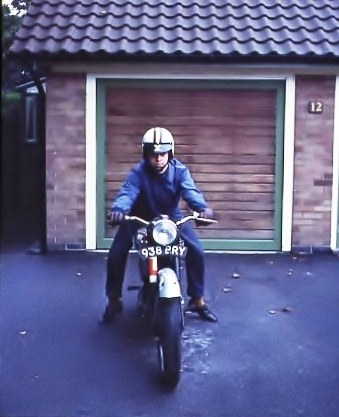 Not
much longer after the breakdown incident after more spirited riding,
the engine started knocking under load, the big end was on the way
out, but it kept going for a bit longer until compression was lost.
I removed the cylinder head and bits of piston ring were embedded in
the piston and cylinder head crown.
At that point I was not sufficiently confident to strip the
engine further. My cousin’s husband knew his cousin, Mick Insley,
who would fix it. So, off the Cub went in the back of an Anglia van
to Midway. I told Mick the big end had gone.
After what seemed ages with summer passing and I had started
driving lessons, I received a message to say the bike was ready. I
got up to Midway, saw the bike and Mick was draining the engine oil.
The big end has gone Mick said. The bike had stood so long
before he started to strip it he had forgotten I had told him the
big end had failed and he had just replaced the piston and cleaned
up the cylinder head.
So I returned home without the Cub.
After the plain big end was replaced by a roller big end
obtained from Wilemans the bike was ready but summer was over and I
had passed my car driving test.
With winter approaching and the prospect of commuting to
Uttoxeter each day on Stevenson’s “Yellow Peril” buses compounded by
parental pressure I bought a Bedford (Vauxhall Viva) HA van.
Not
much longer after the breakdown incident after more spirited riding,
the engine started knocking under load, the big end was on the way
out, but it kept going for a bit longer until compression was lost.
I removed the cylinder head and bits of piston ring were embedded in
the piston and cylinder head crown.
At that point I was not sufficiently confident to strip the
engine further. My cousin’s husband knew his cousin, Mick Insley,
who would fix it. So, off the Cub went in the back of an Anglia van
to Midway. I told Mick the big end had gone.
After what seemed ages with summer passing and I had started
driving lessons, I received a message to say the bike was ready. I
got up to Midway, saw the bike and Mick was draining the engine oil.
The big end has gone Mick said. The bike had stood so long
before he started to strip it he had forgotten I had told him the
big end had failed and he had just replaced the piston and cleaned
up the cylinder head.
So I returned home without the Cub.
After the plain big end was replaced by a roller big end
obtained from Wilemans the bike was ready but summer was over and I
had passed my car driving test.
With winter approaching and the prospect of commuting to
Uttoxeter each day on Stevenson’s “Yellow Peril” buses compounded by
parental pressure I bought a Bedford (Vauxhall Viva) HA van.
I had used the Cub a bit after it was
repaired, and it went well but I was running it in so rides were
steady. I heard of a
lad who was interested in buying it so with winter approaching and I
needed the cash to pay for the van, the now sorted Cub was sold.
However, the seed, although dormant for 6 years, was sown.
O the right is the only photograph of me
astride the Cub on my Mum & Dad’s driveway.
MZ ing continued
- - -
It's been a while but just to remind you I'd
had the carburettor off my MZ ETZ 251 and fitted a new rubber air
inlet hose and left you with a video of my MZ "ticking over" on our
drive, well that's the end of that particular MZ story really but if
your still awake I thought I share with you how my "passion" for
Eastern European bikes started in the first place:
Fortunately or my wife Rena may say
unfortunately social distancing hadn’t been invented back in those
days and we both suffered rather badly from carownervirus and
bikeownervirus (I still do) with no known treatment or vaccine,
causing both of us to make some rather ‘random’ decisions - I wasn’t
going to mention it but I was the proud owner of a blue Russian
Moskvich car - not the finest vehicle I've ever owned but mention it
to indicate how badly infected we both became!!
In later years Rena’s somehow shown a
certain amount of immunity to both infections
- but back then she decided she needed her own powered two
wheel transport for her work at Bass (she's just been made
redundant) and as I was on very friendly terms with Maurice Parnham
the owner of Melbourne Motorcycles having just bought the new Honda
CJ250T from him- he offered Rena a nice little red Honda PC50 which
needed 're-commissioning' at a bargain price - this done I remember
riding it from Branston to Melbourne one sunny Saturday morning for
it’s MoT - at about 30mph
- which it passed. She kept the PC50 for quite some time and
was even 'booked for speeding' on Bass property by the rather over
zealous head of security on her way to work one morning - a fact she
often bragged about!!
However like me wanted she had a yearning
for speed and so swapped it for a bright yellow Puch Maxi two stroke
Sport moped at a motorbike shop who’s name escapes but it was at the
junction of Waterloo St and Dallow St (definitely not Burton Bike
Bits) somewhere opposite where Cycling 2000 now stands. They later
relocated to Stanley St and then I lost touch - anyway back to the
Puch - it was a proper little bike - with a fuel tank in front of
the seat but still twist and go, the poor little bike was thrashed
mercilessly keeping up with my "powerful Honda CJ250T" (it didn't)
until the need for more speed forced us to swap the Puch for a new
Honda CG125 at Jacksons original shop in Waterloo St - by then the
poor little Puch was so knackered that she literally had to pedal it
into Jacksons - I did feel sorry for them !
As
part of the deal John Jackson promised to teach her to ride the bike
as it had a clutch and gears and she’d only previously had twist and
go. I remember John Jackson standing for hours on the town hall
square whilst she practised her clutch and gear routine.
Actually, she didn't learn a thing from John, it was me who
taught her how to ride it - but I obviously never mention this fact
in fear of looking big headed - in fact later that same year Rena
passed her test first time on the CG125 after I took her round and
round the test course which was now around Scalpcliffe Road night
after night. I remember the day of her test - I was now a
maintenance fitter at Grundy Teddington in Hawkins lane - I rang her
from the public pay phone - you remember the days before mobiles -
and when I asked her how she'd gone on she burst into tears. 'Oh
well never mind you can do it again" I said as she blurted out they
were tears of joy she had passed first time - Happy days!!
The problem now was space as we had no
garage at our first house in Branston and it was a tight fit getting
the CG125, CJ250T and BSA A10 in a ten by six shed we’d bought from
Marshments in Shobnall for £40 - looking back I made another bad
decision and reluctantly sold my A10 to a guy in Sudbury and never
saw it again - but I do still have the shed!
Moving on to mid 1980 with a growing family
I wanted reliable cheap transport as I was also now working at Bass
and Rena needed the car to ferry our two small sons around. The
125cc learner law had just come into effect and there was some small
bike bargain to be had. I nearly bought a new Honda CD200 from Stan
Hadfield in Uxbridge St, he was selling Honda’s as well as push
bikes for a while and if I remember correctly offered me a Honda
CD200 for £180 - he said he was stripping it down to sell for spares
if I didn't buy it. Likewise I also looked at a Honda CD185 at
Samways in Derby as they were also now Honda dealers and offering
similar deals. Looking back I should have bought one of these but no
doubt still with that Kawasaki 250 two stroke triple - the one that
got away - in mind I wanted something more ‘exciting ’ and ‘green’
so I bought a metallic green Kawasaki Z250C from Swift Kawasaki
Branston Road opposite what was Norris chemist - no one can ever
remember this shop??
The Kawasaki Z250C was a very different
beast to the triple I’d lusted after in the 70’s in fact it had a
rather boring four stroke single OHC engine that often proved
difficult to start and it spent too much time at the dealers on
guarantee work and too little time in my shed. I have to admit the
Z250C wasn't Kawasaki's finest hour and after the demise of Swift
Kawasaki I approached John Jackson now at their new Borough Road
premises (hoping he'd forgotten Rena's Puch) to do a trade in and
low and behold he'd just become both Kawasaki and MZ agents and was
happy to do a deal. I swapped the Kawasaki for a new silver MZ ETZ
125 mainly due to it being very cheap (we’d just moved house to
Stretton ). I’d actually wanted a 250 but John didn't have one in
stock so I bought the 125 only too pleased to see the back of the
Kawasaki. However, on taking the 125 in for its first service
Jackson’s had now got an MZ ETZ250 and he offered me a favourable
deal so bikes were swapped and a shiny new silver MZ ETZ 250 was all
mine. - This became another ‘problem child’ bike and could be a
story in itself however to keep things simple the bike was
eventually returned to the importer - Wilf Green - in Sheffield. It
came back faultless and I sold it to an avid MZ club member and
former work mate and bought a Honda CB650Z (four cylinder 650)
advertised in the Derby Telegraph from a private vendor in
Worthington near Ashby.
I’d always wanted a 4 cylinder bike with
electric start and remember driving over in our brown Vauxhall Astra
with my wife and two young boys to look at the bike after a Sunday
overtime shift at work, it had an oil leak but I was offered the
bike at a much reduced price and I became its new owner. I ended up
completely stripping the bike down - frame and engine. In order to
get to work I’d bought a little blue 50cc Honda Express from
Melbourne Motorcycles (now owned by Geoff and John) from their shop
opposite Renold Chains the Honda was unique in that it had a
clockwork spring powered starter and of course "I always met the
nicest people!!"
The CB650Z Honda was my first major bike
renovation since the A10 many years previously - it started out as
an engine strip to cure the oil leak because as you all know -
JAPANESE BIKES NEVER LEAK OIL !!
- On inspection it was all down to a little rubber 'O' ring
in the cylinder block through which oil returns from the single over
head cam shaft which had gone hard with age and heat. But I also
noticed the end cylinder was badly scoured and took it over to
Palins in Derby for honing and later that evening got a phone call
from Dave Hodgkinson who I later got to know very well and in who's
workshop I spent many happy hours with the CB650 and later with
three 400/4’s I rebuilt. At Dave’s suggestion I had one oversized
piston +50 in this cylinder and the other 3 were standard as Dave
said this was common practice on race bikes. Whilst the engine was
out I had the frame etc powder coated, new fuel tank, seat, side
panels, bikini fairing etc, etc. Most parts were purchased from
Palins in Derby and David Silver Spares, I met David Silver at the
1986 NEC and think this may have been his first time at the show
with a small stall.
In the meantime, the new owner of my MZ
ETZ250 kept telling me to accompany him to the MZ club - held once a
month at the Dun Cow pub in Colton near Rugeley. So off I went and
after attending and taking part on runs on my CB650Z - you guessed I
bought another second hand MZ (no3) a red TS150 from an elderly MZ
club member in Rugeley. This bike needed "re-commissioning" (as
usual) and after a few jobs finally passed its MOT again at
Melbourne Motorcycles - if I remember they were MZ agents at that
time - I often wish I'd bought a Silver Star 500cc with a four
stroke single Rotax engine from them as they are quite sought after
now - in MZ circles!! - however, I was unable to get this particular
purchase past the 'Bank of Rena', it was the one that got away. To
be continued - - -
MZ ing
Ariel VNH update Pt2
Last time I reminded you about where the
original V twin bones came from and what happened to them.
This time a little more up to date.
Last year, (2018) after many years sitting
under the bench while I built other bikes and got on with other
mechanical projects, I decided it was time to finally do a few
updates to the VNH motor.
Some of these updates I learnt while building my Norton V
twin motor, other things I wanted to do because of small problems
which were unknowingly built into the original Ariel engine.
(I mentioned this engine in Part 1, the Norton V was built
after the VNH Ariel motor.)
When the engine was first started it was quite
oily and smoked quite bad on start up.
Although, when it had been running a short while the smoke
did die down. One of
the original things I did was to have external oil pipes in the sump
to return the oil to the tank via the oil pump.
The other problem was the pistons had no oil
ring groves.
I believe the pistons I had were WD (I could be
wrong, again) and naively thought if they ran OK in that engine, why
not in mine (the fool)? I
picked up some oil control rings and turned groves in the pistons to
suit and rebuilt the top of the motor.
Well, it was a lot better, but it still had a
lot of oil inside the combustion chamber on start-up, eventually the
smoke cleared in a couple of miles as I previously said.
This was very embarrassing.
One Saturday morning after a short ride I took the engine
out, stripped it down and replicated the internal oil pickups in the
standard Ariel engine.
The reason I didn’t do this in the first place was it just looked a
little to tricky drilling inside the wall of the crankcase to pick
up the back of the oil pump and I didn't have time, so did a short
cut, silly boy.
It was a long job with a lot of setting up, but
I managed to get everything lined up and carefully drilled the
holes. While I had the
engine apart, I fitted internal flywheel scrapers to stop oil being
thrown about too much by the flywheels.
The next day I rebuilt the motor and fitted into the frame
and gave it a try.
Yes, you guessed it, still the same, oh well,
it was a little better and the motor was a lot tidier without the
external pipe work.
I decided to live with it for the time being (9
years to be precise) as it never oiled a plug and at least it would
never seize up.
I later found out talking to folks who knew
more than me (there's plenty of them about) that old V twins were
prone to over oil the rear cylinder as the flywheels throw oil up
the bore unless they had baffle plates in the mouth of the
crankcase.
If you look in the top of these old engines
with the barrels off you can see the con rod poking through a slot
in the casting and the flywheels were shielded by this, only lube to
the big end could escape up the bore and consequently no smoky
engine.
I do hope your still awake and keeping up or
understand what I'm on about.
����
When I originally converted Adrie’s castings
into patterns and had the crankcases cast, I was aware of allowing
for casting shrinkage. However,
looking at the engine last year I decided the flywheels still ran
too close to the inside of the crankcases, so, I decided to take
about 3/8" off the diameter of the flywheels.
This meant splitting the flywheels to hold in the lathe.
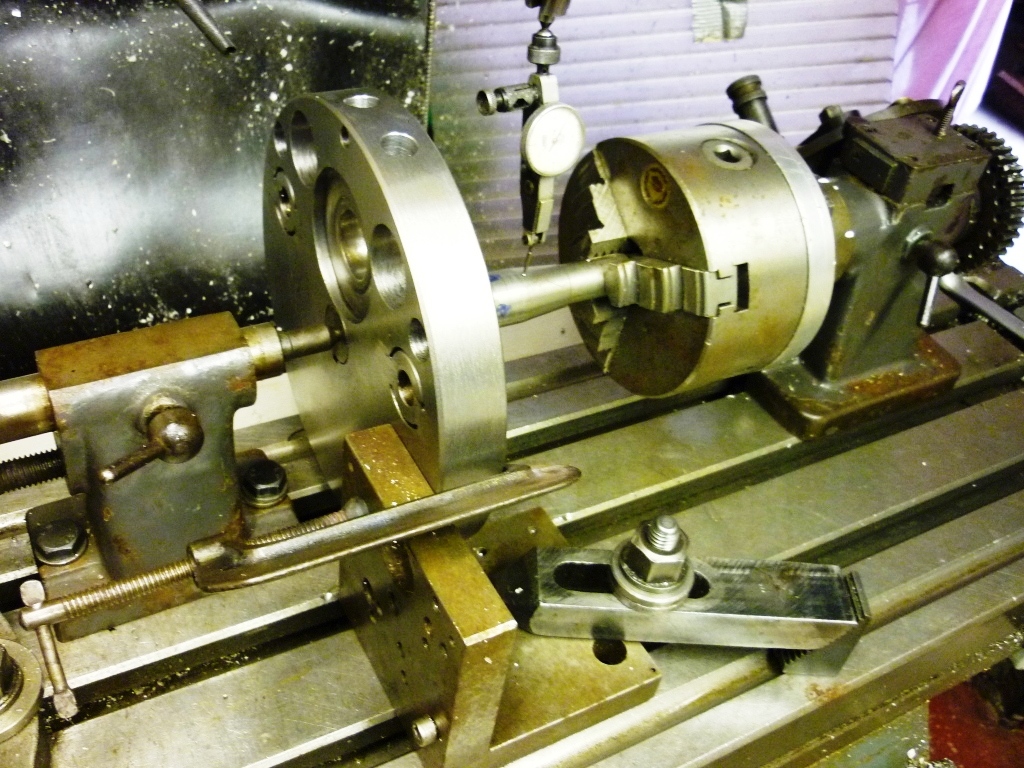
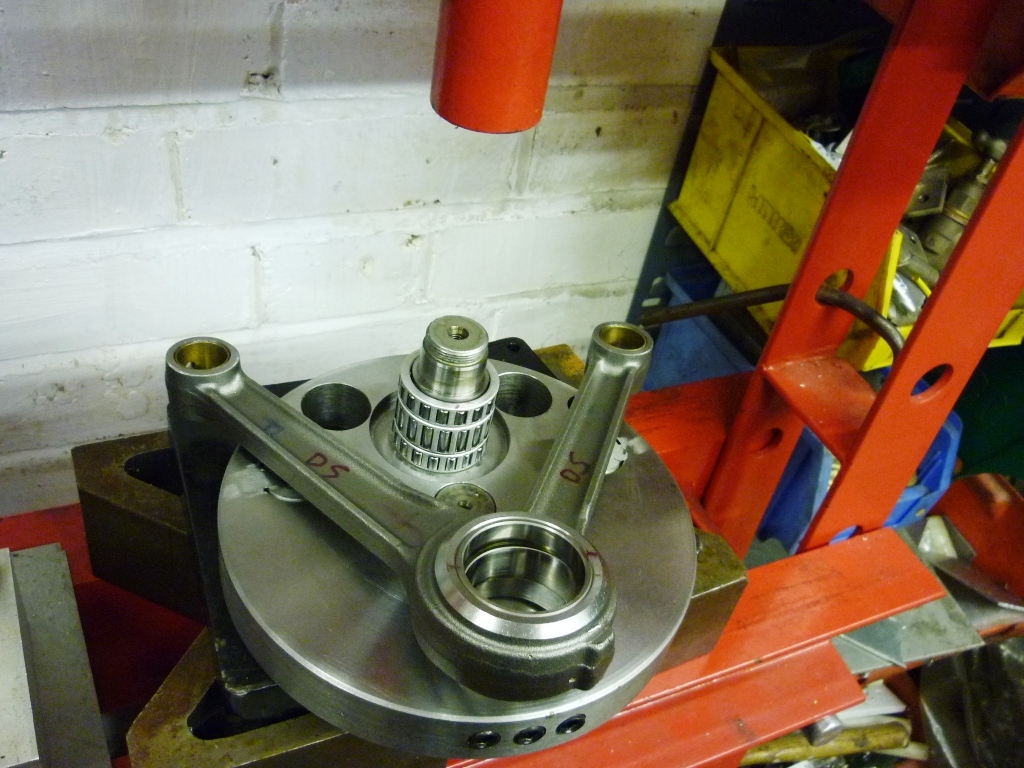
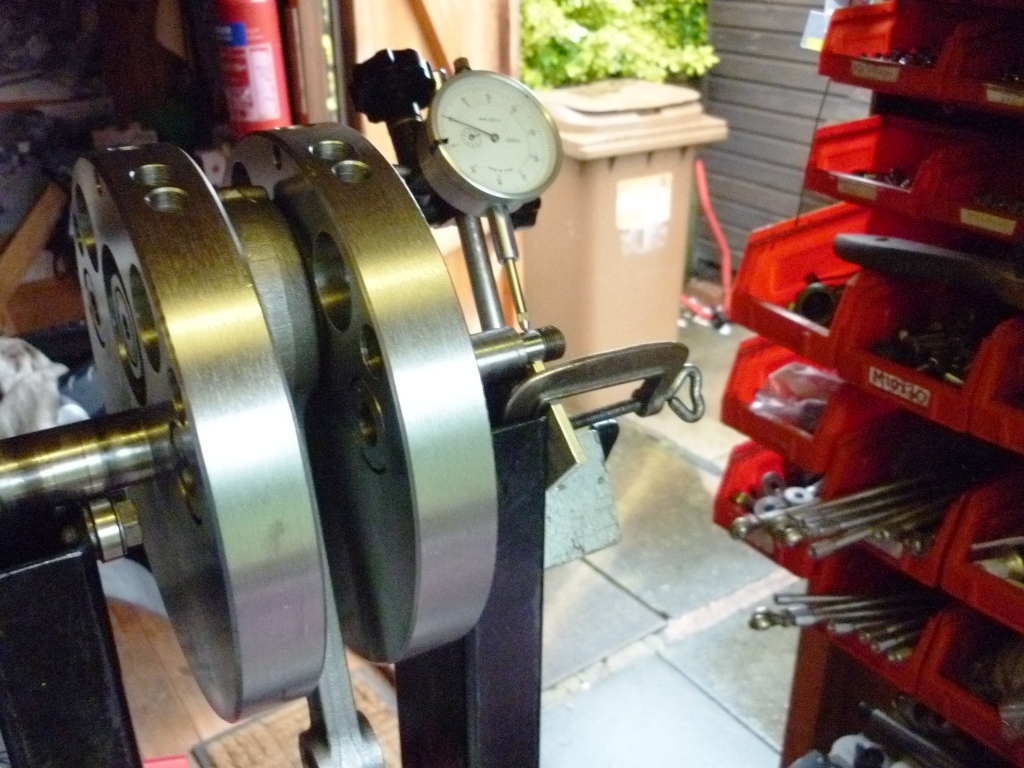
I also wanted to use original Ariel Chaincases
and use a cush drive on the end of the crank as the original engine
had. The problem was I
had machined a taper on the drive side mainshaft and fitted a pulley
for a belt drive, this ran a Lucas alternator on the end of the
crank. All this ran in
a Norton Commando chain case on the original build.
The Ariel chaincase did not have room for all
this gubbins. As I was
now putting the motor into an Ariel frame, I wanted it all to look
as standard ish as possible.
After turning material off the flywheels, I
then set the drive side flywheel and mainshaft up on the miller and
machined a spline on the end of the mainshaft to take an early
Triumph sprocket carrier, cam and spring.
The reason I did this was I had a range of sprockets for
these and the sprocket does not run on the mainshaft but a hardened
carrier on the crank unlike the Ariel.
I also decided to fit two more extra flywheel oil scrapers at the same time. Belt, braces and a bit of string. I'm sure Honda do this all the time with new models.
����The cam gears I originally fitted were an odd
pair I had (the only pair I had at that time) and were worn.
When I stripped the engine, they hadn't got any better.
Fortunately, I acquired a new pair and the crank pinion had
three keyways which helped with better cam timing later on.
I also never liked the idea of push in exhaust
pipes. They just rattle
loose eventually and wear the exhaust port oversize.
To sort this out I have done an upgrade on the heads which I
will tell you about in another little article later.
This is the problem with development, it’s
always clever to be wise in retrospect.
All this work I hope should keep the motors combustion
chamber free from oil but still should allow enough to lube the
bores etc, time will tell.
A this stage the bottom half of the engine was
assembled and the next job was to sort the chassis out.
This will be in part three as my wife has just informed me my tea is ready. Tony. To be continued ……
